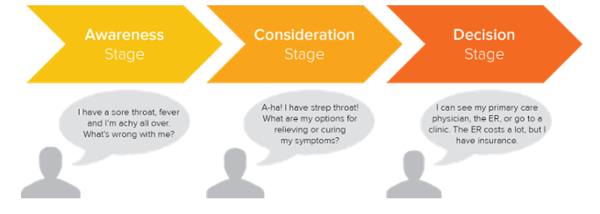Mapping Content for Different Stages of the Customer Journey
It doesn’t matter if your goal is to acquire leads, build sales or increase conversions, content plays a crucial role in moving people through the buyers’ journey. With a staggering 4.39 billion internet users worldwide creating content is a key way to reach an audience where they are. From videos to images to blogs, content helps your prospective customers and leads learn about you as a brand, gather information about your products and services. it also assists you, as a business, in positioning yourself as an expert in your field.
 It is incontrovertible fact that good quality content marketing delivers real business benefit. It can generate up to three times more leads than paid search advertising alone and it’s reported that around 64% of users are more likely to buy a product online after engaging with video content around that product. The data around content marketing proves that there is real, measurable and scalable value in investing in a good content marketing strategy.
It is incontrovertible fact that good quality content marketing delivers real business benefit. It can generate up to three times more leads than paid search advertising alone and it’s reported that around 64% of users are more likely to buy a product online after engaging with video content around that product. The data around content marketing proves that there is real, measurable and scalable value in investing in a good content marketing strategy.
Content marketing has evolved since its early inception. mostly taking on the form of blogs. Now, however, it’s so much more than just blogs. It is videos, social media stories, blogs, landing pages, surveys, paid advertising, guides, articles, interviews, emails, newsletters, gated content, images and more! But with so much content that can be created, how do you make sure that you plan and create the right content at the right time to move your ideal buyer personas through their customer journey to ultimately buy from your business?
An Explanation of The Buyers Journey
Traditionally, there are three stages of the buyer’s journey; awareness, consideration and decision. Some models show post-purchase as a buyer’s journey stage and whilst this stage is relevant in terms of turning your customers into advocates and really delighting them, content is not so relevant at that stage; so, this piece will focus on the main three stages.
Awareness
The awareness stage is when the prospective customer may first realise they have a problem or a need. At this stage, they will start gathering more general information related to their problem or need. A potential problem could be an operations manager realising that his workplace needs to be more organised but isn’t, yet, aware of the right solution for his business.
Consideration
Entering the consideration stage, prospective customers or leads have a more complete understanding of their problem or need and are now starting to evaluate potential solutions. They are not quite ready to buy as they still need a bit of help to understand what the best option for them looks like.
Decision
As customers enter the decision stage, they are now more ready to buy. At this stage, customers have done the bulk of their research and now understand both their problem and what their ideal solution probably looks like. They may need to seek some final information on why they should choose a particular brand, product or service from those on offer. Be aware, their decision may not be based entirely on the factual specifics of the solution on offer, but may also have an emotional element based on affinity and relationship.
An example
Think about a time when you have been ill and imagine you are using the US healthcare system. You have a sore throat and then with a bit of research you find out you have strep throat. Therefore, you enter the consideration stage and consider what options are available to you to heal or relieve the symptoms of a sore throat. Finally, entering the decision stage you assess which of the solutions is the best for you.

Another example is going on holiday. You may start by being aware that you want to go on holiday to a hot country but aren’t quite sure where. You may go to a search engine and look for an article ‘What countries in Europe are hot in October?’ From this you may discover that Spain, Italy and France all have regions that experience high temperatures late into the season. You then start considering reviews about each place or search for a Spain vs Italy comparison article. Finally, you may come to the decision that Spain seems the best choice for your needs (budget, activities, hotel type, coastline, accessibility, reviews etc) however before you make the purchase you may also want to search for ‘Deals in Spain.’
How to create content for each stage
As you can see, the buyer’s journey is complex. Unless customers are loyal to a brand or service or know the solution they require, they are likely to spend time (relative to the type of problem) researching and gathering information online in order to inform a decision.
If we bring this back to SEO and customer intent, in order to create content that resonates with your personas at each stage we must understand the language they may use when they search and what sort of content they expect at different stages. This is where keyword modifiers come in. The types of words customers use will be different depending on what stage they are at. Here are some examples:
|
Awareness |
Consideration |
Decision |
|
What Where How Who Why Improve Troubleshoot Resolve |
Best Types Review Which Service Solution |
Brand Buy Appointment Deals Discount Code Book Test
|
Once you know this, you can start mapping out and creating content that answers queries in the appropriate way at different points in the buyer’s journey.
Types of Content
The types of content you create at different stages will vary but once you understand what your customers are searching for and the language they are using, you can they start mapping out the content and format you need.
Awareness Stage Content
At the awareness stage, customers are going to Google (or use other search engines) looking for information to educate themselves on a particular topic or search for content that addresses their problem. At this stage customers are unlikely to be familiar with your brand, products or services, so content should not be sales focused, but should be educational and informative in nature. Types of content that work well for this stage of the journey are blogs, social media posts, video, infographics, images and podcasts. Don't forget to use the words in the table above as a guide in your planning.
Consideration Stage Content
As your potential customers start to become aware of the available solutions to their problem, they will start researching in more detail the various products and services they feel have potential to help them.
Types of content that can be used at this stage include quizzes, webinars, free ebooks or downloadable guides, explainer videos or webinars. Blog posts are still relevant at this point however the tone and topic will be different to that of the awareness stage. A blog or video at this stage could be a comparison of two products or solutions for example.
Decision Stage Content
During the decision stage, customers may have some final questions or concerns before they buy. Using content at this stage should convince your potential customers to buy your products or services. Content at this stage include demos, case studies, FAQs, product landing pages, reviews and testimonials.
Get Started on Mapping Content
Content mapping and planning your content strategically is a good way to ensure you produce content that moves potential customers through their buyers journey effectively and, ideally, towards converting with you. Whilst this may be a simplified version and your full customer journey may be a whole lot more complex, this guide should hopefully give you some useful tips on how to get started. high-quality, strategic content is key to a successful inbound marketing strategy so it's essential to get it right. If you are unsure what topics to use for your content why not try Answerthepublic or GoogleTrends to give you some data-based guidance?
However, if you need more help and guidance on how to plan and execute a successful content strategy or would prefer to leave it to the experts, don’t hesitate to get in touch. We are Surrey based inbound marketing agency, Innovation Visual and we can help.








